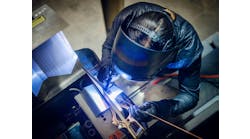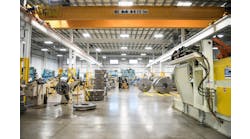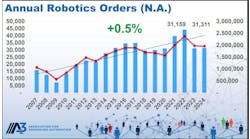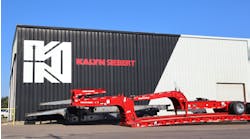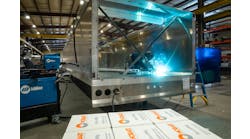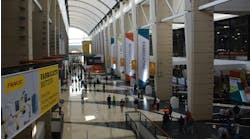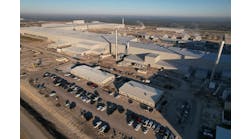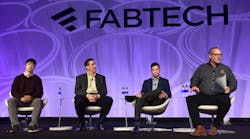If a task is “dirty, dull, or dangerous,” that’s a task that needs to be automated—but that doesn’t mean a worker will lose his job—or so panelists at the recent FABTECH expo explained in their “State of the Industry” discussion of the latest in robotics and the impact on modern manufacturing.
“There is this big trend that has surged toward automation, particularly with robotics, and it’s really stimulated the conversation that robots are coming to take your job,” said panel moderator Jay Douglass, chief operating officer at ARM (Advanced Robotics for Automation), a consortium formed to drive innovation. “I don’t think that’s true, but I’d like to talk a little bit about how investments in technology actually can overcome this shortage of workers.”
Indeed, the point is to use robots and automation to free up people to tackle the more challenging aspects of manufacturing, explained Tyler Vizek, project innovation engineer at MxD, The Digital Manufacturing Institute, an organization formed to make the factory floor more agile.
“There is this common opinion that robots and automation are here to take jobs. There’s no doubt there will be work that human beings aren’t doing anymore,” Vizek said. “But we have to start looking at it from our perspective that it’s not the job—because when we think ‘job’ we consider a job is for a person—but it’s the tasks that make up that job that are actually going to be the areas in which automation moves forward.
“Where it’s repetitive or dangerous, this is where automation is really going to make the biggest difference. Automation, these advances in technologies, allow us to free up time for workers for tasks that are uniquely human; it’s leading, it’s creating, it’s strategizing, it’s emphasizing. These are areas that, as we add automation into the mix on the factory floor, we have the ability to redefine humans’ role—and there’s no doubt that the human is the most flexible asset. How can we empower the workforce to focus on the jobs that are value-adds, and to come into work every day with a better attitude?”
One challenge facing automated systems designers is that humans are actually very complex, and things that people do routinely are actually very difficult to model and replicate.
“There’s a lot that’s overlooked as far as how important the human is in manufacturing systems,” said Steve Czajkowski, head applications engineer at Siemens Industry Inc, who runs the company’s motion control business unit. “And there’s so much that’s done, so much that’s learned and so many conclusions that are drawn that are very hard to capture with digital technology.
“And when people consider the digital twin, often they’re focused on machines, focused on processes, focused understanding these in the context of the larger picture. But the human component is becoming more and more important. We’re evluating a project that looks at the interactions between human being and human being, and human being and machine, because these interactions are very hard to model: the complex, physiological, psychological, behavioral characteristics of the human being that’s very hard to capture.”
Robot as coworker
The panel also explained the important differences between autonomous, stand-alone industrial robots and the so-called “cobots,” or collaborative robots that work alongside humans.
“I see many manufacturers who decided to test or research and use cobots because they don’t want to replace jobs or they may be unionized, or they have different reasons why they want to try out robotics where a human worker can be right next to the robot,” said Mingu Kang, CEO of Aris Technology, a company that’s focused on automating 3 D scanning for manufacturers. “These robots are built to be slower and more safe, and in some ways less efficient—but that actually drives the decision for the factories to be able to test the validity of human collaboration.
“So you may be replacing a particular type of task, but a lot of times that task being grayed out for that worker actually makes them more productive to work on other tasks that only a human can do. So it’s almost like a step-by-step investment for many manufacturers.”
Kang cited metrology as an example of an area where cobots are a good alternative, because human inputs are needed. And Douglass then provided an example from his lab.
“These genuinely are partnerships between the robot arm and the worker, and I do think that that’s going to be a continuing trend,” Douglass said. “The American workforce is already the most productive in the world, and this is really going to put us at a different level.”
But industry might not have much choice, noted Vizek, who pointed out that by 2025 some 2.5 million people currently working in manufacturing are expected to retire, contributing further to the tight labor market.
“You have a lot of value that you’re losing in terms of manufacturing GDP,” Vizek said. “So when you consider robotics or AI as a labor multiplier, you’re now allowing people to do what they’re good at—but you’re still taking advantage of the work that needs to be done with the systems and technology that can do that. Instead of replacing jobs, we’re moving people to do things they’re good at, and then filling the shortage where we can with robotics.”
Of course, the value of an investment in automation is different for every application.
“I think industrial robots have hit an inflection point as far as adoption,” Vizek said. “ROI for automation vs skilled labor is a case-by-case basis. What are the unique needs of your business? What do you have the expertise and resources available to accomplish?”
MxD currently has a project that trains a robot, through imaging sensors and machine learning algorithms, to recognize the quality of welds in real time, for example.
“A really skilled welder is said to be able to identify the quality of a weld by how it sounds. And that is some knowledge that is built up over years and years of performing that trade and becoming an expert,” Vizek said. “But as we look to the future, if we’re going to be able to continue doing high-quality welding in the manufacturing environment and competing for new workers, machine learning and AI is going to be able to help folks that haven’t built up those years of experience to be able to utilize this technology—and all of a sudden be able to understand the quality of welds in real time.
“This is going to reduce costs in rework and scrap. So I think of it, again, as technology to augment the worker, not to replace skilled labor.”
But machine learning isn’t an instant solution, cautioned Kang.
“A lot of times we talk about AI and machine learning and consider, ‘Hey, if I collect the data and run this science I’m going to replace this person,’ but it’s not really true,” Kang said. “If your data is imperfect, you can only get to a certain level of conclusion with machines that experts can really get to easily.
“However, if the sensor can measure better than yourself—more accurately, more precisely, more repeatably, etc—then that machine learning over time can be more efficient than that particular worker. So if that combination actually happens, I would assume that it means increasing the types of jobs that will be potentially replaced by automation.”
Education and the next generation
The “education piece” is critical, emphasized Czajkowski of Siemens.
“We’re working with a variety of community colleges across the country, looking to bring technology into their programs,” Czajkowski said. “We have one customer that’s located in central Ohio that has trouble attracting workers. They basically set up an apprentice program, and they’re taking people who want to work in the area—who don’t want to leave the town that they grew up in—and they’re quite good when they come out. And so that’s the push a lot of people are making.”
ARM’s Douglass agreed, and explained the importance of making such opportunities attractive.
“A guy on our workforce team used to work at a community college in southwestern Pennsylvania. They put out this great new program, inviting people to come and take courses to learn about manufacturing. Nobody signed up,” Douglass said. “For the next year, they changed the name to robotics technology; booked it solid. So it’s marketing, it’s vocabulary. But it’s also social norms and the way society evolves.”
And society—in turn, the workforce—is evolving rapidly as the world goes digital.
“Technology like robotics, machine learning, Internet of Things: These are very exciting to the incoming generations. I’m sure robotics and automation is growing as a potential career choice,” Vizek said. “The adoption of this technology will not only act as a labor multiplier; it will pull in the next generation of the workforce.
“These are systems that have a lot of potential and allow people to not only work on specific manufacturing tasks—your trades, fabrication—but bring in other domains like computer science and control theory.”
Douglass suggested that it’s important for everyone—particularly those in the industrial workforce—to “keep an open mind.”
“When I go out and talk to people, it’s very clear to me that if you’re a business owner or operator, the laws of nature are that if you’re not doing everything you can to improve your product cost, your product quality, by definition you’re going out of business—so don’t be afraid to take the right steps,” Douglass said. “It’s always an economic argument; it’s rarely a technical one. What this industry continues to need are smart, creative people to solve these problems.
“Leave the magic to the people at the universities: they’re going to get their pretty quick. Be smart, be creative in your business the best way you can.”
Likewise, Czajkowski reemphasized that robotics and automation are not here to replace humans.
“There really needs to be a deep understanding and a deep discovery of where automation can be implemented to really add value and augment our workforce,” he said. “And that starts with the current and future leaders. These are decisions that we can make and really look at how we redefine humans’ role in the future factory and in next-generation manufacturing. So whether you’re just starting, or whether you’re far on your journey toward digital transformation or robotics, you need to start thinking about it.
“There’s a lot of noise out there, but it doesn’t make sense for every company to do what everyone else is doing. It requires some work, but it’s definitely a necessity for us to invest in this technology.

